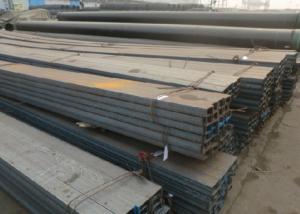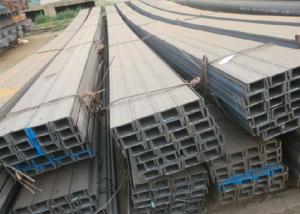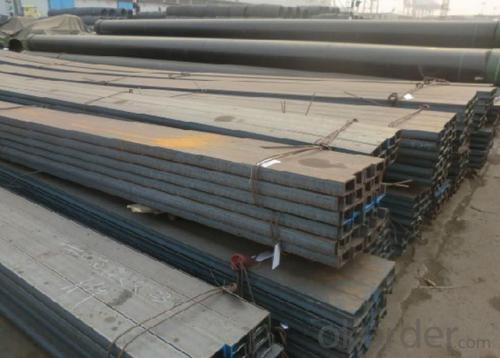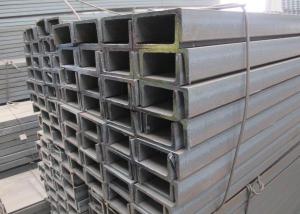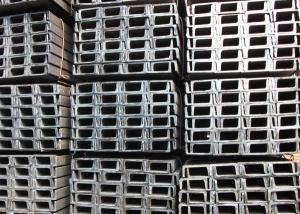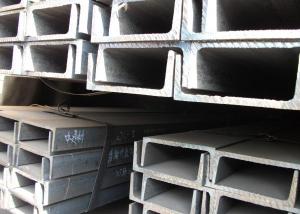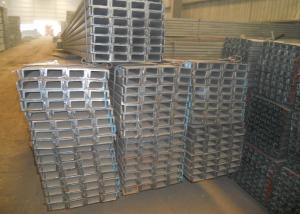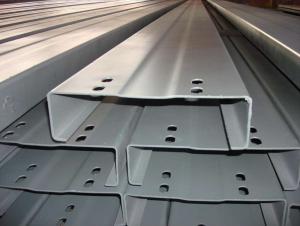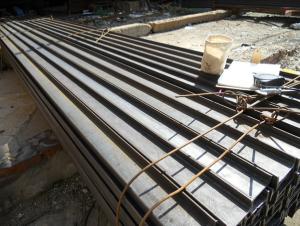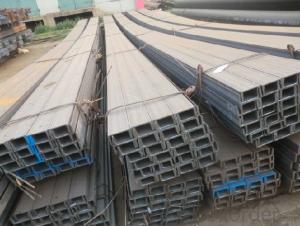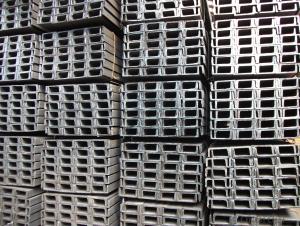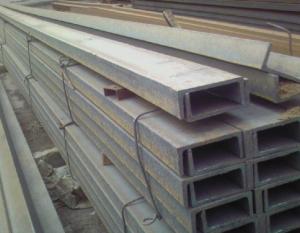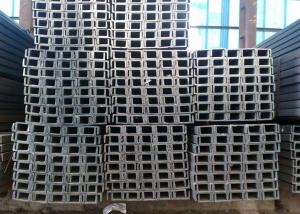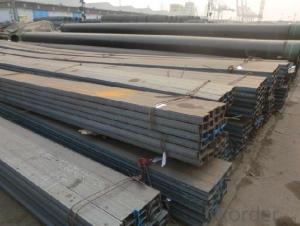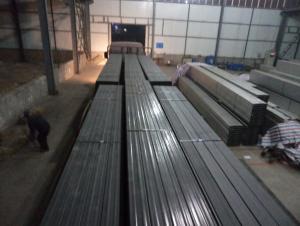MS Channel
- Loading Port:
- Xingang Port
- Payment Terms:
- TT or LC
- Min Order Qty:
- 25MT m.t.
- Supply Capability:
- 5000MT/Month m.t./month
OKorder Service Pledge
OKorder Financial Service
You Might Also Like
Specifications of MS Channel:
1.We supply high quality MS Channel at reasonable price, including Chinese standard, Japanese standard and so on.
Standard | GB/JIS |
Material Grade | Q235,SS400 |
Technique: | Hot Rolled |
Sizes as per chinese standard: | 50*37*4.5mm - 300*89*11.5mm
|
Sizes as per japanese standard: | 50*25*3mm – 200*80*7.5mm |
Length: | 6meter, 9meter, 12meter |
Note: 1.we are also competent to provide our customers other MS Channel based on other sizes according to customer’s requirements.
2. The length of our ms channel could be cut into other meters as per customer’s requirements. For example, the channel in 6meters could be cut into 5.8meters in order to be fit in the 20ft container.
2. The detailed sections of MS Channel as per GB standard.are shown in the table-1:
GB U CHANNEL | Standard | Sectional | Dimension |
| Mass: |
| (mm) | (mm) | (mm) | (mm) |
|
50X37 | 50 | 37 | 4.50 | 7.0 | 5.438 |
63X40 | 63 | 40 | 4.80 | 7.5 | 6.634 |
80x43 | 80 | 43 | 5.00 | 8.0 | 8.045 |
|
|
|
|
|
|
100x48 | 100 | 48 | 5.30 | 8.5 | 10.007 |
120x53 | 120 | 53 | 5.50 | 9.0 | 12.059 |
140x58 | 140 | 58 | 6.00 | 9.5 | 14.535 |
140x60 | 140 | 60 | 8.00 | 9.5 | 16.733 |
|
|
|
|
|
|
160x63 | 160 | 63 | 6.50 | 10.0 | 17.240 |
160x65 | 160 | 65 | 8.50 | 10.0 | 19.752 |
|
|
|
|
|
|
180x68 | 180 | 68 | 7.00 | 10.5 | 20.174 |
180x70 | 180 | 70 | 9.00 | 10.5 | 23.000 |
|
|
|
|
|
|
200x73 | 200 | 73 | 7.00 | 11.0 | 22.637 |
200x75 | 200 | 75 | 9.00 | 11.0 | 25.777 |
|
|
|
|
|
|
220x77 | 220 | 77 | 7.00 | 11.5 | 24.999 |
220x79 | 220 | 79 | 9.00 | 11.5 | 28.453 |
|
|
|
|
|
|
250x78 | 250 | 78 | 7.00 | 12.0 | 27.410 |
250x80 | 250 | 80 | 9.00 | 12.0 | 31.335 |
250x82 | 250 | 82 | 11.00 | 12.0 | 35.260 |
|
|
|
|
| |
280x82 | 280 | 82 | 7.50 | 12.5 | 31.427 |
280x84 | 280 | 84 | 9.50 | 12.5 | 35.823 |
280x86 | 280 | 86 | 11.50 | 12.5 | 40.219 |
|
|
|
|
|
|
300x85 | 300 | 85 | 7.50 | 13.5 | 34.463 |
300x87 | 300 | 87 | 9.50 | 13.5 | 39.173 |
300x89 | 300 | 89 | 11.50 | 13.5 | 43.883 |
Table-1
3. The chemical composition of HR Channel Steel according to Q235B is shown in Table-2.
Alloy No | Grade | Element(%) | ||||
C | Mn | S | P | Si | ||
Q235 | B | 0.12-0.20 | 0.3-0.7 | ≦0.045 | ≦0.045 | ≦0.3 |
Table-2
Note: we are able to present our customers relevant SGS test report for chemical composition of HR Channel Steel.
4. The mechanical property of HR Channel Steel according to Q235B is shown in Table-3-1 and Table-3-2
Alloy No | Grade | Yielding Strength Point(Mpa) | |||
Thickness(mm) | |||||
≦16 | >16-40 | >40-60 | >60-100 | ||
≧ | |||||
Q235 | B | 235 | 225 | 215 | 205 |
Table-3-1
Alloy No | Grade | Tensile Strength(Mpa) | Elongation After Fracture(%) | |||
Thickness(mm) | ||||||
≦16 | >16-40 | >40-60 | >60-100 | |||
≧ | ||||||
G235 | B | 375-500 | 26 | 25 | 24 | 23 |
Table-3-2
Note: we are able to present our customers relevant SGS test report for mechanical property of MS Channel as customer’s request.
Applications of MS Channel:
The MS Channel can be applied to construction of warehouses, workshops, sport stadiums and car parks etc.The hot rolled channel steel belongs to carbon structural steel which is applied to in the field of construction and machinery.In details, the hot rolled channel steel is usually used for arch-itechtural structure, and they could be welded in order to support or hang a vari-ety of facilities. They are also usually used in combination with I beam. Generally,the hot rolled channel steel we supply must possess perfect welding property, riveting property and mechanical property and so on.
Package & Delivery of MS Channel:
1.The hot rolled channel steel will be packed in bundle with steel wire at each end of every bundle and color marking in order to help the customer to recognize his goods more easily at sight.
2. And the hot rolled channel steel could be loaded into 20ft or 40ft container, or by bulk cargo.If the weight of each bundle reaches more than 3.5 mt, the loading by break bulk cargo should be choosed.When the weight of each bundle reaches less than 3mt, the loading by container should be choosed.
3.As for the transportaion from mill to loading port, the truck will be usually used. And the maximum quantity for each truck is 40mt.
4.All in all, we could do in accordance with customer's request.
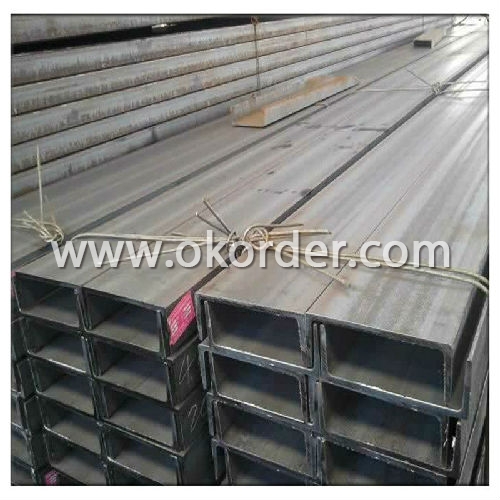
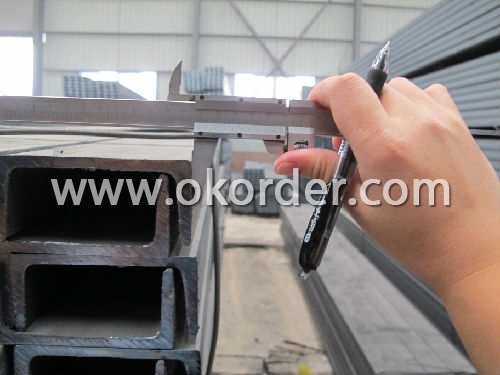
Production Flow of MS Channel:
1.The steel billet shall be heated in the high temperature furnace.
2. The heated steel billet shall be rolled five to nine times with the aim of shaping the general figure of steel u channel.
3. The hot rolled channel steel should be put onto the cooling bed to make the temperature low.
4. The channel steel should be straighted on the straightener.
5. The straighted channel steel will be cut into meters by saw, as per customer's requirements.
- Q: What are the different types of accessories available for steel channels?
- Steel channels have a variety of accessories that serve specific purposes and enhance their functionality. Some common accessories include: 1. Brackets: Used for additional support, especially when the channels are installed vertically or at an angle. Brackets maintain structural integrity and prevent sagging or bending. 2. End Caps: Cover the ends of channels for a clean and finished appearance. They also protect the edges from corrosion, moisture, and external elements. 3. Connectors: Join two or more channels together. Available in different shapes and sizes, such as straight, angle, and T-connectors, made of metal for a strong connection. 4. Mounting Hardware: Includes screws, bolts, and nuts to securely fasten channels to surfaces or structures, ensuring they can withstand intended loads. 5. Sliding Trolleys: Used when channels need to support movable loads or equipment. Allows smooth and easy movement along the channels for flexibility and convenience. 6. Cable Management Accessories: Facilitate cable management within channels. Examples include cable clamps, ties, trays, and routing fittings. Organize and secure cables for an efficient system. 7. Hangers and Supports: Used to suspend or hang channels from ceilings, walls, or other structures. Provide stability, especially for heavy loads. 8. Protective Coatings: Not accessories per se, but essential for enhancing durability and resistance to corrosion. Galvanization or powder coating protects against rust, moisture, and environmental factors. These are just a few examples of the accessories available for steel channels. Depending on specific applications, there may be additional accessories or variations to optimize performance and functionality.
- Q: Are steel channels suitable for high-rise buildings?
- High-rise buildings can indeed utilize steel channels as they possess the necessary strength and versatility. Commonly referred to as C-channels or U-channels, steel channels serve as integral components in the construction of tall structures. These channels exhibit exceptional load-bearing capacity and structural stability, making them ideal for supporting the weight of multi-story buildings. Their ability to withstand heavy vertical loads enables efficient distribution throughout the structure. Moreover, steel channels are known for their resistance to bending and torsion, ensuring that high-rise buildings maintain their structural integrity even in the face of extreme circumstances like earthquakes or strong winds. Another advantage of steel channels lies in their ease of fabrication and installation, simplifying the construction process. They are available in various sizes and shapes, allowing for customized designs that cater to the specific requirements of high-rise buildings. Additionally, steel channels can be effortlessly connected to other structural elements, such as beams or columns, establishing a robust and enduring framework for the entire edifice. Furthermore, steel channels possess a high strength-to-weight ratio, enabling them to provide substantial structural support while keeping the overall weight of the building relatively low. This proves particularly advantageous for tall structures as it reduces the overall load on the foundation and lowers construction expenses. Furthermore, the utilization of steel channels permits flexible and adaptable designs, empowering architects and engineers to create innovative and efficient high-rise structures. In conclusion, steel channels are exceptionally well-suited for high-rise buildings due to their strength, structural stability, ease of fabrication and installation, as well as their capacity to withstand extreme conditions. Their versatility and efficiency make them the preferred choice for constructing high-rise buildings that are safe, durable, and aesthetically pleasing.
- Q: Can steel channels be used in coastal areas?
- Yes, steel channels can be used in coastal areas. However, it is important to consider the corrosive effects of saltwater on the steel. Proper coatings and maintenance are necessary to protect the steel from corrosion caused by the saltwater environment.
- Q: Are steel channels suitable for the oil and gas industry?
- Steel channels are well-suited for the oil and gas industry, as they possess exceptional strength, durability, and resistance to corrosion. In this industry, steel is widely utilized due to these attributes. Specifically, steel channels are commonly employed for structural support and framing in various oil and gas facilities, including pipelines, refineries, and offshore platforms. The utilization of steel channels ensures a remarkable load-bearing capacity, enabling them to withstand the demanding conditions typically encountered in the oil and gas industry. These conditions involve extreme temperatures, high pressures, and exposure to corrosive substances. Moreover, steel channels are easily fabricated and installed, making them a cost-effective option for a wide range of applications. Furthermore, steel channels can be tailored to meet specific requirements, such as varying sizes, lengths, and thicknesses. This adaptability ensures their compatibility with the unique demands of different oil and gas projects. Additionally, steel channels can be galvanized or coated with protective coatings to enhance their resistance to corrosion. This further extends their lifespan and minimizes the need for maintenance. In conclusion, steel channels possess numerous advantages that render them well-suited for the oil and gas industry. These advantages encompass their strength, durability, resistance to corrosion, ease of fabrication and installation, and customization options. Consequently, the utilization of steel channels contributes to the reliable and efficient operation of oil and gas facilities, making them the preferred choice in this industry.
- Q: Can steel channels be used for overhead garage doors?
- Yes, steel channels can be used for overhead garage doors. Steel channels provide strong and durable support for the weight of the garage door. They are often used as the vertical tracks for the door, guiding the door as it opens and closes. Steel channels are known for their strength and resistance to bending or warping, making them a reliable choice for overhead garage doors. Additionally, steel channels can be customized to fit the specific dimensions of the garage door, ensuring a proper and secure installation.
- Q: How do steel channels contribute to load distribution?
- Steel channels contribute to load distribution by providing structural support and distributing the weight of the load evenly across the channel's length. These channels help to minimize stress concentrations and ensure that the load is evenly distributed to prevent any localized areas from bearing excessive weight.
- Q: Can steel channels be used for creating support structures for plumbing systems?
- Indeed, support structures for plumbing systems can be fashioned using steel channels. Renowned for their robustness and long-lasting nature, steel channels are ideal for upholding the weight of plumbing pipes and fixtures. By furnishing a stable and secure foundation, they guarantee proper alignment and support for the pipes. Moreover, steel channels possess remarkable load-bearing capabilities, enabling them to withstand substantial burdens, thereby preventing any sagging or bending of the pipes as time passes. Furthermore, steel channels can be effortlessly tailored and crafted to fit the precise demands of the plumbing system, rendering them an adaptable alternative for constructing support structures.
- Q: What are the different types of support methods for steel channels?
- There are several different types of support methods for steel channels, including cantilever support, beam support, wall support, and braced support. Cantilever support involves fixing the steel channel at one end and allowing it to extend freely. Beam support involves placing the steel channel on top of a beam that provides support along its entire length. Wall support involves attaching the steel channel to a wall or vertical surface for support. Braced support involves using diagonal braces or supports to provide additional stability and support to the steel channel.
- Q: What are the different alloy compositions available for steel channels?
- There are several different alloy compositions available for steel channels, each with its own unique properties and advantages. Some common alloy compositions include: 1. Carbon Steel: This is the most basic and widely used type of steel. It contains primarily iron and carbon, with small amounts of other elements. Carbon steel channels offer good strength and durability, making them suitable for various applications. 2. Stainless Steel: This alloy composition includes iron, chromium, and nickel. Stainless steel channels are highly corrosion-resistant and have excellent strength and heat resistance. They are commonly used in environments where resistance to rust and staining is crucial, such as in the food industry or marine applications. 3. Alloy Steel: This composition includes iron, carbon, and other alloying elements such as manganese, chromium, or molybdenum. Alloy steel channels offer enhanced strength, hardness, and wear resistance compared to carbon steel. They are often used in applications requiring high tensile strength, such as construction, automotive, or machinery manufacturing. 4. High-Strength Low-Alloy (HSLA) Steel: HSLA steel channels contain small amounts of alloying elements like copper, vanadium, or niobium. These alloys enhance the strength and toughness of the steel while maintaining good weldability and formability. HSLA steel channels are commonly used in structural applications, bridges, or automotive components. 5. Weathering Steel: This composition includes iron, chromium, and copper. Weathering steel channels are designed to develop a protective rust-like coating when exposed to the atmosphere. This coating acts as a barrier against further corrosion and eliminates the need for painting. Weathering steel channels are often used in outdoor structures like bridges or building facades. It is important to select the appropriate alloy composition based on the specific requirements of the application, considering factors such as strength, corrosion resistance, weldability, and cost. Consulting with a materials engineer or steel supplier can help determine the most suitable alloy composition for steel channels.
- Q: What are the different finishing techniques for steel channels?
- Steel channels have multiple options for finishing techniques that enhance their appearance and protect against corrosion. One widely used technique is galvanizing, which involves applying a thin layer of zinc to the channels. This zinc coating provides excellent corrosion resistance and can be applied through hot-dip galvanizing or electroplating. Galvanized steel channels have a distinct silver-gray look. Another option is powder coating, where a dry powder is applied to the channels and then baked to create a durable and decorative finish. Powder coating comes in various colors and provides a smooth and even coating. Painting is also commonly used, with liquid paint applied to the channels through brushing, spraying, or dipping. This not only improves appearance but also acts as a protective barrier against corrosion. Polishing and brushing are additional techniques that create smooth and shiny or textured surfaces, respectively. Polishing removes imperfections and produces a reflective surface, while brushing uses wire brushes or abrasive pads to achieve a textured finish. In summary, there are numerous finishing techniques for steel channels, each with its own advantages and aesthetic appeal. The choice of technique depends on factors such as desired appearance, corrosion resistance needs, and cost considerations.
1. Manufacturer Overview
| Location | Tangshan, China |
| Year Established | 2000 |
| Annual Output Value | Above US$ 50 Million |
| Main Markets | Mid East; Southeast Asia; Korea |
| Company Certifications |
2. Manufacturer Certificates
| a) Certification Name | |
| Range | |
| Reference | |
| Validity Period |
3. Manufacturer Capability
| a) Trade Capacity | |
| Nearest Port | Tianjin |
| Export Percentage | 20% - 30% |
| No.of Employees in Trade Department | 10-20 People |
| Language Spoken: | English; Chinese |
| b) Factory Information | |
| Factory Size: | Above 81,000 square meters |
| No. of Production Lines | 1 |
| Contract Manufacturing | OEM Service Offered |
| Product Price Range | Average |
Send your message to us
MS Channel
- Loading Port:
- Xingang Port
- Payment Terms:
- TT or LC
- Min Order Qty:
- 25MT m.t.
- Supply Capability:
- 5000MT/Month m.t./month
OKorder Service Pledge
OKorder Financial Service
Similar products
Hot products
Hot Searches
Related keywords
